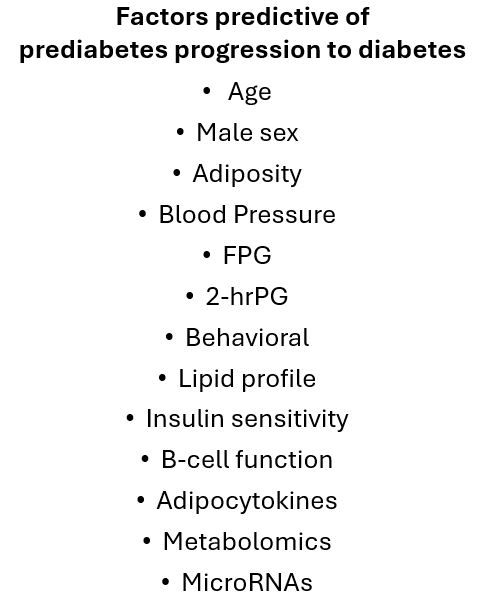Prediabetes is Not A Benign Condition, Warned Samuel Dagogo-Jack, MD, MSc, at ACP 2025
Dagogo-Jack reviewed alarming data on the damage prediabetes can inflict even decades before a diabetes diagnosis and offered guidance to the internal medicine audience.
Samuel Dagogo-Jack, MD, DSc, presented a comprehensive clinical update on prediabetes management for internal medicine physicians at the 2025 American College of Physicians Internal Medicine Meeting, April 3-5, in New Orleans. Dagogo-Jack, AC Mullins Endowed Professor of Medicine and director of the division of endocrinology, diabetes, and metabolism at the University of Tennessee Health Science Center, presented alarming and compelling data for the danger presented by the increasingly prevalent metabolic condition as well as evidence-based approaches to screening, diagnosis, and management.
The Proverbial Tip of the Iceberg

Alarmingly, despite affecting an estimated 97.6 million adults in the US and 860 million people worldwide, population awareness of prediabetes remains remarkably low, Dagogo-Jack said. Recent data indicate awareness rates have improved somewhat, from just 4%-7.7% in 2005-2006 to approximately 20% in 2020-2022. Unfortunately, that translates to 80% of the population living with prediabetes remaining vulnerable to progression to full blown type 2 diabetes.
Dagogo-Jack also presented data that highlighted stark deficiencies in frontline assessment and detection of glucose tending toward diabetes. Research by Mainous et al found that fewer than 1% of patients with laboratory-confirmed prediabetes noted in the medical record were actually diagnosed with the condition, and only 23% received appropriate treatment recommendations.
Diagnostic Criteria, Screening Recommendations
Dagogo-Jack reviewed the American Diabetes Association's diagnostic criteria, which define prediabetes as fasting plasma glucose (FPG) 100-125 mg/dL, 2-hour plasma glucose (2-hPG) 140-199 mg/dL during oral glucose tolerance test (OGTT), or hemoglobin A1c (HbA1c) 5.7%-6.4%.
However, he highlighted important caveats in the application of these criteria. Data from the NHANES 2005-2010 revealed significant ethnic variations in glycemic marker distributions, with non-Hispanic Black individuals showing higher HbA1c values compared to non-Hispanic White individuals (P <.001), even at similar glucose levels. And while HbA1c is still considered the “gold standard” for diabetes diagnosis, the finding suggests limitations on the measure as a universal diagnostic marker across ethnic groups.
Dagogo-Jack moved on to research that shows low concordance rates between different prediabetes diagnostic tests. Referring again to NHANES data, for this example from 2011 to 2014, he noted that 28.3% of US adults had elevated FPG, 21.7% had elevated HbA1c, and 13.3% had elevated 2-hPG, but only 4.1% showed elevations across all three markers. Dagogo-Jack used the divergence to highlight the challenges in establishing consistent diagnostic approaches.
Silent Threat, Serious Complications
Prediabetes has long been considered a warning sign rather than a disease state, but emerging evidence clearly demonstrates that complications commonly associated with type 2 diabetes can begin even before full-blown disease develops. Dagogo-Jack shared data showing that nearly 50% of adults with type 2 diabetes already show signs of diabetic retinopathy, neuropathy, or nephropathy at the time of diagnosis, underscoring the fact that microvascular damage starts well before glucose levels reach thresholds for a diagnosis of diabetes. He also cited research that found nearly 20% of people with prediabetes have evidence of chronic kidney disease based on estimated glomerular filtration rate measurements. The cardiovascular risks of prediabetes are equally concerning. Individuals with impaired glucose tolerance (IGT) face a 2-fold higher risk of cardiovascular disease
Data from longitudinal studies demonstrate that β-cell dysfunction occurs early in the disease process, with evidence for reduced β-cell volume in individuals with prediabetes compared to those with normal glucose tolerance.
Prediabetes, Dagogo-Jack stressed, is an early stage of metabolic dysfunction that can lead to severe, life-altering complications if left unaddressed.
Pathophysiology and Progression

Dagogo-Jack shared findings from his own Pathobiology of Prediabetes in A Bi-racial Cohort (POP-ABC) study, which followed African-American and Caucasian offspring of parents with type 2 diabetes—born with “pristine glycemic profiles.” Not all participants progressed to prediabetes, he said, but the findings revealed robust evidence for a range of predictors of progression, including age, male sex, adiposity, blood pressure, baseline glycemic values, insulin sensitivity, and β-cell function. Dagogo-Jack showed data from diabetes prevention studies performed throughout the world that indicated annual progression rates from prediabetes to diabetes ranging from 5.8% to 18.3%, making the case, again, for early recognition and intervention.
Management Approaches and Reversal Strategies
Current ADA guidelines recommend referring adults with prediabetes to intensive lifestyle programs modeled after the Diabetes Prevention Program (DPP), with goals of 7% weight loss and >150 minutes per week of moderate-intensity physical activity. For certain high-risk individuals—those with BMI ≥35 kg/m², age <60 years, FPG ≥110 mg/dL, HbA1c ≥6.0%, or women with history of gestational diabetes—metformin should be considered, although it remains off-label for this indication.
Dagogo-Jack referred numerous times in his presentation to the potential for reversing prediabetes not with medication but with relatively simple lifestyle modifications to diet and physical actively. He highlighted findings from his Pathobiology and Reversibility of Prediabetes in A Bi-racial Cohort (PROP-ABC) study. This work demonstrated that sustained lifestyle changes can not only prevent progression to diabetes but actually reverse prediabetes to normal glucose regulation.
Data from the DPP Outcomes Study showed that the number of times participants attended a follow-up visit with glucose at a normal level directly correlated with type 2 diabetes risk reduction: 47% for one-time normalization, 61% for two occurrences, and 67% for three occurrences.
Clinical Implications
Dagogo-Jack offered his own practical take-home points for clinicians:
- Multiple testing modalities (FPG, 2-hPG, HbA1c) are available for prediabetes diagnosis, though concordance is limited
- HbA1c results should be interpreted with caution, particularly in non-White populations
- Prediabetes is associated with significant micro- and macrovascular complications
- Lifestyle intervention remains the cornerstone of management
- While no medications are FDA-approved specifically for prediabetes, metformin may be appropriate for high-risk individuals
Dagogo-Jack reiterated the urgent need for improved recognition and management of prediabetes at the primary care level stressing that intervention can make a difference.